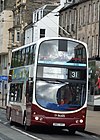
The Caledonian Railway (CR) was a major Scottish railway company. It was formed in the early 19th century with the objective of forming a link between English railways and Glasgow. It progressively extended its network and reached Edinburgh and Aberdeen, with a dense network of branch lines in the area surrounding Glasgow. It was absorbed into the London, Midland and Scottish Railway in 1923. Many of its principal routes are still used, and the original main line between Carlisle and Glasgow is in use as part of the West Coast Main Line railway.

Edinburgh Waverley is the principal railway station serving Edinburgh, Scotland. It is the second busiest station in Scotland, after Glasgow Central. The station serves as the northern terminus of the East Coast Main Line, 393 miles 13 chains from London King's Cross, although some trains operated by London North Eastern Railway continue to other Scottish destinations beyond Edinburgh.
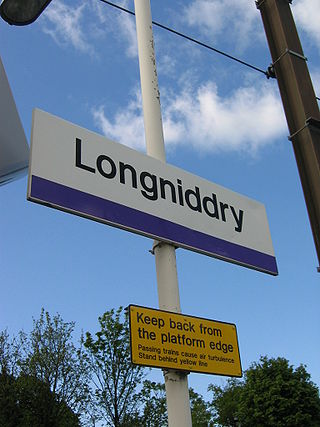
Longniddry railway station is located at the southeast corner of the coastal village of Longniddry, East Lothian, Scotland. The station is on the East Coast Main Line, 13+1⁄4 miles (21.3 km) east of Edinburgh Waverley, and is served by stopping passenger trains on the North Berwick Line.

Dundee railway station serves the city of Dundee on the east coast of Scotland. It is situated on the northern, non-electrified section of the East Coast Main Line, 59+1⁄4 miles (95.4 km) northeast of Edinburgh. Dundee is the tenth busiest station in Scotland. In January 2014, the former main station building was demolished to make way for a new building as part of the Dundee Waterfront Project which opened on 9 July 2018.

Slateford railway station is a railway station serving Slateford in the city of Edinburgh, Scotland. It is located on the Shotts Line from Glasgow Central to Edinburgh Waverley via Shotts. The station has two platforms, connected by a stairway footbridge, and CCTV. It is managed by ScotRail.

Kingsknowe railway station is a railway station serving Kingsknowe in the Scottish city of Edinburgh. It is located on the Shotts Line from Glasgow Central to Edinburgh Waverley via Shotts. The station has two platforms, connected by a level crossing, and CCTV. It is managed by ScotRail.

Kirknewton railway station is a railway station serving the village of Kirknewton in West Lothian, Scotland, Opened as Kirknewton in February 1848, the station was renamed Midcalder and Kirknewton after two months, before becoming Midcalder in 1855. The full circle was finally completed 127 years later in May 1982 when the name reverted to Kirknewton. This was to distinguish it from Kirknewton station near Mindrum on the NER Cornhill Branch.
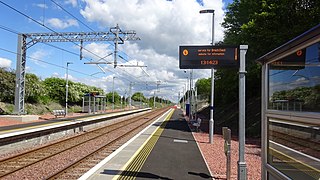
Breich railway station is a rural railway station serving the village of Breich in West Lothian, Scotland. It is located on the Shotts Line, 21 miles (34 km) west of Edinburgh Waverley towards Glasgow Central. It was the sixth-least-used station in the UK until 2018-19 and was the second-least-used in Scotland, after Barry Links as well as being the least used station in West Lothian.
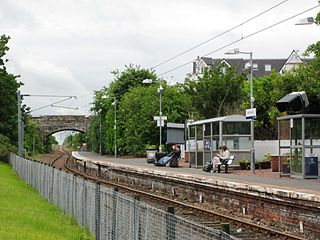
North Berwick railway station is a railway station serving the seaside town of North Berwick in East Lothian, Scotland. It is the terminus of the Edinburgh to North Berwick Line, 22+1⁄4 miles (35.8 km) east of Edinburgh Waverley.

Bellshill railway station is a railway station in the town of Bellshill, North Lanarkshire, Scotland. The station is managed by ScotRail and served by Argyle Line and Shotts Line services. The station is adjacent to Bellshill Main Street, on Hamilton Road, and was opened by the Caledonian Railway as part of the Cleland and Midcalder Line on 1 May 1879. West of the station, the Glasgow, Bothwell, Hamilton and Coatbridge Railway crossed with a second station in the town to the north west - this ceased to carry passengers back in 1951.

Carstairs railway station serves the village of Carstairs in South Lanarkshire, Scotland and is a major junction station on the West Coast Main Line (WCML), situated close to the point at which the lines from London Euston and Edinburgh to Glasgow Central merge. Constructed originally by the Caledonian Railway, the station is managed today by ScotRail who also operate most services which serve the station; it is also served by one TransPennine Express service per day between Manchester Airport and Glasgow Central and one Caledonian Sleeper service each way per day between Glasgow Central and London Euston. All other services by TransPennine Express and services operated by Avanti West Coast, CrossCountry and London North Eastern Railway pass the station, but do not stop.

The Glasgow–Edinburgh via Carstairs line is a main railway route which connects the Scottish cities of Glasgow and Edinburgh, by means of their respective sections of the West Coast Main Line (WCML).
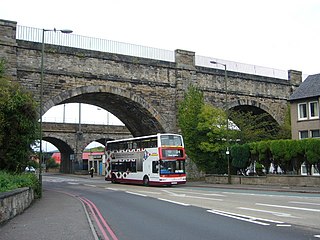
Slateford is an area of Edinburgh, the capital of Scotland. It is east of the Water of Leith.
The Clydesdale Junction Railway company was formed to build a railway connecting Motherwell and Hamilton with Glasgow, in Scotland.
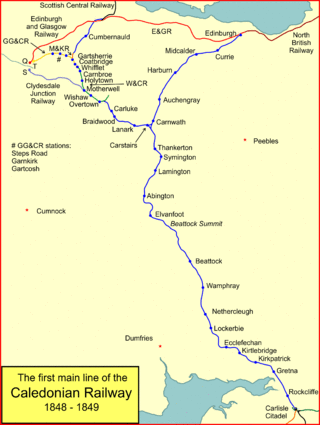
The Caledonian Railway main line in Scotland connected Glasgow and Edinburgh with Carlisle, via Carstairs and Beattock.

Leith Central Railway Station was a railway station in Leith, Scotland. It formed the terminus of a North British Railway branch line from Edinburgh Waverley. The station was built on a large scale, and it included a trainshed over the platforms.
Cleland and Midcalder Line is a historic railway line in Scotland. Built by the Caledonian Railway and opened in 1869, it provides a link between Glasgow and Edinburgh through the mining communities of Lanarkshire and West Lothian.

Merchiston railway station was a railway station which served the area of Merchiston in Edinburgh, Scotland, for around eighty years. The station was built by the Caledonian Railway between 1879 and 1883, with the last passenger service in September 1965. The station was demolished shortly afterwards and the track bed has become a footpath.
The Balerno line was a short loop railway in the southern suburbs of Edinburgh, Scotland. It was 6 miles in length, leaving the main Caledonian Railway Edinburgh to Carstairs line at Slateford, and rejoining it at Ravelrig. It was built by the Caledonian Railway mainly to service the many manufacturing enterprises situated along the upper Water of Leith, and passenger trains also ran. The line opened in 1874. As well as at Balerno, stations were constructed at Colinton, Juniper Green and Currie. The line was steeply graded.
The Caledonian Railway lines to Edinburgh started with the main line that reached Edinburgh in 1848 as part of its route connecting the city with Glasgow and Carlisle. The potential of the docks at Granton and Leith led to branch line extensions, and residential development encouraged branch lines in what became the suburbs of Edinburgh. In 1869 a line was opened from Carfin through Shotts giving the Caledonian a shorter route between Glasgow and Edinburgh.























